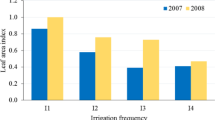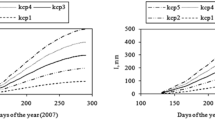Abstract
In this study, the interaction between crop load and irrigation level on yield, fruit size, skin color and stem-end splitting fruit ratio in the apple cultivar ‘Gala, Galaxy’ grafted on rootstock M9 were investigated. Six irrigation programs were applied during the whole growth season: deficit irrigation (rates of 0.25 kc, 0.50 kc, 0.75 kc), full irrigation (rate of 1.00 kc), excess irrigation (rate of 1.25 kc) and non-irrigation (rates of 0.00 kc of “Class A” pan evaporation coefficient). Four crop loads in each irrigation application were performed by hand thinning after the June drop as a- a low crop load (3 fruits cm−2 TCA), b- a medium crop load (5 fruits cm−2 TCA), c- a heavy crop load (7 fruits cm−2 TCA), and d- an un-thinned crop load (> 7 fruits cm−2 TCA). The total tree yield increased with crop load and irrigation levels. Fruit size was significantly increased by the low crop load. Irrigation increased the fruit size compared to non-irrigation treatment. Further 0.75 kc, 1.00 kc and 1.25 kc irrigation treatments significantly increased the fruit length. Irrigation reduced the fruit flesh firmness. While the low crop load increased the skin red color, it decreased the fruit skin brightness. The yellowness of skin decreased with increasing in the irrigation amount. Irrigation reduced the skin brightness and yellowness, but it increased red color. Crop load and irrigation significantly affected the stem-end splitting fruit ratio. While the splitting fruit ratio increased with a decrease in the crop load, it decreased with an increase in irrigation amount, relatively. Consequently, the low and medium crop load treatments would be beneficial to increase the ratio of marketable fruits without any significant losses in yield for ‘Gala’ apple, especially under 0.75 kc deficit irrigation treatment.
Zusammenfassung
In dieser Studie wurde bei der Sorte ‘Gala, Galaxy’, veredelt auf der Unterlage M9, die Wechselwirkung zwischen Behangdichte und Bewässerungsmenge in Bezug auf Ertrag, Farbe der Fruchtschale und Anteil der Früchte, die am Stielansatz aufplatzen, untersucht. Sechs abgestufte Bewässerungsprogramme wurden während der gesamten Vegetationsperiode durchgeführt: Defizitbewässerung (bei kc = 0,25, kc = 0,50 und kc = 0,75, Pflanzenkoeffizienten, jeweils bezogen auf die Referenzverdunstung nach Class A-pan), optimale Bewässerung (bei kc = 1,00), Überschussbewässerung (bei kc = 1,25) und ohne Bewässerung (bei kc = 0,00 Class A-pan).
Nach dem Junifruchtfall wurden in jeder Beregnungsvariante vier verschiedene Behangdichten per Handausdünnung hergestellt: a. geringe Behangdichte mit 3 Früchten pro cm2 Stammquerschnitt, b. mittlere Behangdichte mit 5 Früchten pro cm2 Stammquerschnitt, c. hohe Behangdichte mit 7 Früchten pro cm2 Stammquerschnitt und c. eine nicht ausgedünnte Kontrolle mit mehr als 7 Früchten pro cm2 Stammquerschnitt. Der Gesamtertrag pro Baum steigerte sich mit der Behangdichte und der Bewässerungsintensität. Die Fruchtgröße steigerte sich signifikant bei geringer Behangdichte. Verglichen mit der nicht bewässerten Variante verbesserte die Bewässerung generell die Fruchtgröße. Des Weiteren vergrößerte die Defizitbewässerung bei kc = 0,25, kc = 0,50 und kc = 0,75 die Fruchtlänge in einem signifikanten Ausmaße. Die Bewässerung verminderte die Fruchtfleischfestigkeit. Während die geringe Behangdichte bei den Früchten den Anteil der roten Deckfarbe steigerte, nahm die Leuchtkraft im Gegenzuge ab. Mit Zunahme der Bewässerungsstärke nahm die gelbe Farbe der Fruchtschale ab. Die Bewässerung verminderte die Leuchtkraft und den Gelbanteil der Fruchtschalenfarbe, aber sie erhöhte der Anteil an roter Deckfarbe. Die Behangdichte und die Bewässerung beeinflussen das Aufplatzen der Früchte am Stielansatz signifikant. Während der Anteil der aufgeplatzten Früchte mit abnehmender Behangdichte mehr wurde, nahm er mit zunehmender Bewässerungsintensität relativ ab. Zusammenfassend lässt sich sagen, dass, insbesondere mit einer Defizitbewässerung bei kc = 0,75, niedrige und mittlere Behangdichten günstig sind, um den Anteil marktfähiger Früchte zu steigern, ohne einen signifikanten Ertragsverlust bei der Sorte ‘Gala‘ verbuchen zu müssen.










Similar content being viewed by others
References
Akgül M, Başayiğit L (2005) Detailed soil survey and mapping of Suleyman Demirel University farming land. J Nat Appl Sci 9:56–63
Anconelli S, Mannini P, Solimando YD, Guidoboni G (2008) Effetti della gestione irrigua sul melo tramite stress idrico controllato. Frutticoltura 5:52–59
Andrews PK (1994) Physiology of water related stresses in fruit trees. In: Irrigation TF, Williams KM, Ley TW (eds). Good Fruit Grower ISBN 0-9630659-5-5, USA
Andrews PK (2001) ‘Gala’ splitting. Washington Tree Fruit Postharvest Conference March 13th & 14th, page 1–6. Wenatchee, WA
Basak A (2006) The effect of fruitlet thinning on fruit quality parameters in the apple cultivar ‘GALA’. J Fruit Ornam Plant Res 14:143–150
Cheng L, Xi G, Lakso A, Goffinet M (2007) How does nitrogen supply affect ‘Gala’ fruit size? NYFQ 15:3–5
Compton J (2001) Stem-end split and internal ring crack of ‘Gala’ and ‘Fuji’. Plant and pest advisory. Rutgers cooperative extension at the New Jersey agricultural experiment station 6: 1–6
Duran G (1990) Effect of RDI on apple tree (cv. Royal ‘Gala’) growth, yield and fruit quality in a humid environment. PhD Thesis Massey University 243 pp
Fereres E, Goldhamer DA, Sadras VO (2012) Yield response to water of fruit trees and vines: guidelines. In: Crop Yield Response to Water, Fereres, E., (ed.). FAO Irrigation and Drainage Paper 66, ISBN 978-92-5-107274-5
Greene DW, Autio WR (1998) Thinning apples chemically. U Mass Extension Factsheet F–118R
Huang XF, Li GY, Wang XW, Zeng DC, Sun NJ (2001) Water use of micro- sprinkler irrigated apple trees under full irrigation and regulated deficit irrigation. Transactions CSAE 17:43–47
Jackson JE (2003) Flowers and fruits. In: Biology of apples and pears. Cambridge University Press, Cambridge, pp. 315–316
Kilili AW, Behboudian MH, Mills TM (1996) Composition and quality of ‘Braeburn’ apples under reduced irrigation. Scientia Horticuhurae 67:1–11
Lakso AN (2003) Water relations of apples. In: Ferree DC, Warrington IJ (eds) Apples: botany, production and uses. CABI Publishing Series, Wallingford, pp. 167–194
Lakso AN, Goffinet MC (2013) Apple fruit growth. NYFQ 21:11–14
Mahhou A, Dejong TM, Shackel KS, Cao T (2006) Water stress and crop load effects on yield and fruit quality of Elegant Lady peach [Prunus persica (L.) Batch]. Fruits 61:407–418
Mpelasoka BS, Behboudian MH, Ganesh S (2001) Fruit quality attributes and their interrelationships of 'Breaburn' apple in response to deficit irrigation and to crop load. Gartenbauwissenshaft 66: 247-253.
Naor A (2011) Irrigation and crop load influence fruit size and water relations in field-grown ‘Spadona’ pear. J Amer Soc Hort Sci 126:252–255
Naor A (2014) Crop load and irrigation interactions—a new dimension of RDI. Acta Hort 1038:113–120
Naor A, Gal Y, Bravdo B (1997) Crop load affects assimilation rate, stomatal conductance, stem water potential and water relations of field-grown Sauvignon blanc grapevines. J Exp Bot 48:1675–1680
Naor A, Klein I, Hupert H, Grinblat Y, Peres M, Kaufman A (1999) Water stress and crop level interactions in relation to nectarine yield, fruit size distribution, and water potentials. J Amer Soc Hort Sci 124:189–193
Naschitz S, Naor A (2005) The effect of crop load on tree water consumption of ‘Golden Delicious’ apples in relation to fruit size an: operative model. J Amer Hort Sci 130:7–11
Nielsen D, Nielsen GH, Herbert L, Guak S (2010) Effect of irrigation and crop load management on fruit nutrition and quality for Ambrosia/M.9 apple. Acta Hort 868:63–72
Opara UL (1993) A study of stem-end splitting in apples. PhD Thesis. Massey University, New Zealand, p 293
O’Rourke D (2013) World apple review. Ed. Belrose, Inc., USA, p 128
Palmer JW, Giuliani R, Adams HM (1997) Effect of crop load on fruiting and leaf photosynthesis of ‘Braeburn’/M.26 apple trees. Tree Physiol 17:741–746
Racsko J (2006) Crop load, fruit thinning and their effects on fruit quality of apple (Malus domestica Borkh.). J Agric Sci 24:29–35
Sadras VO, Trentacoste ER (2011) Phenotypic plasticity of stem water potential correlates with crop load in horticultural trees. Tree Physiol 31:494–499
Sham M, Bussi C, Lescourret F, Genard M, Habib R, Gilreath J (2005) Pruning intensity and fruit growth in ‘Alexsandra’ peach. Proc Fla State Hort Soc 118:266–269
Stopar M, Tojnko S, Ambrozic TB (2007) Fruit thinning of ‘Gala’apple trees using ethephon, NAA, BA and their combinations. Pomologia Croatica 13:143–151
Webster T (2002) Current approved thinning strategies for apples and pears and recent thinning research trials in Europe. Compact Fruit Tree 35:73–76
Wünsche JN, Greer DH, Laing WA, Palmer JW (2005) Physiological and biochemical leaf and tree responses to crop load in apple. Tree Physiol 25:1253–1263
Yıldırım FA, Yıldırım AN, Askın MA, Kankaya A (2007) The effect of chemical applications on thinning and fruit quality of ‘Galaxy Gala’ apple cultivar grafted on M9 rootstock. Turkey V, National Horticultural Congress, Erzurum, pp 282–285
Author information
Authors and Affiliations
Corresponding author
Rights and permissions
About this article
Cite this article
Yıldırım, F., Vural, E., Uçar, Y. et al. Interaction of Crop Load and Irrigation on Yield, Fruit Size, Color and Stem-end Splitting Ratio of Apple c.v. ‘Gala, Galaxy’. Erwerbs-Obstbau 58, 103–111 (2016). https://doi.org/10.1007/s10341-015-0262-6
Received:
Accepted:
Published:
Issue Date:
DOI: https://doi.org/10.1007/s10341-015-0262-6




